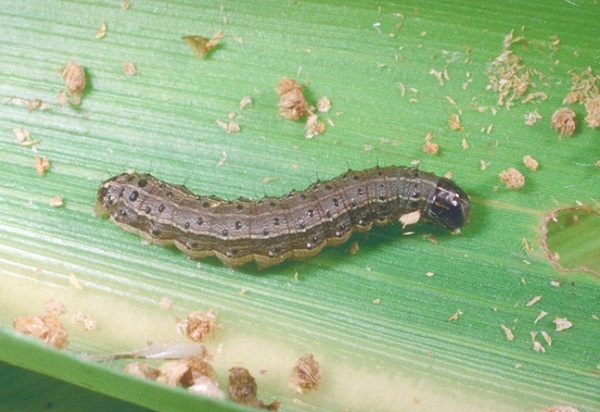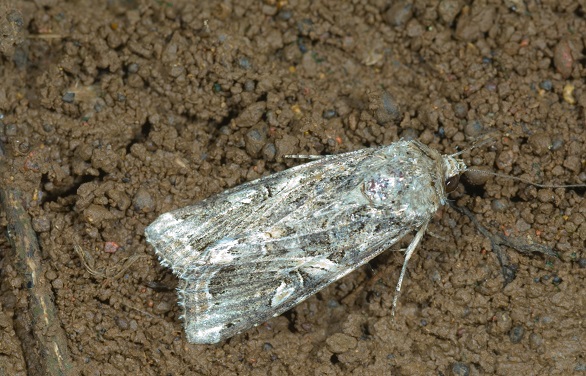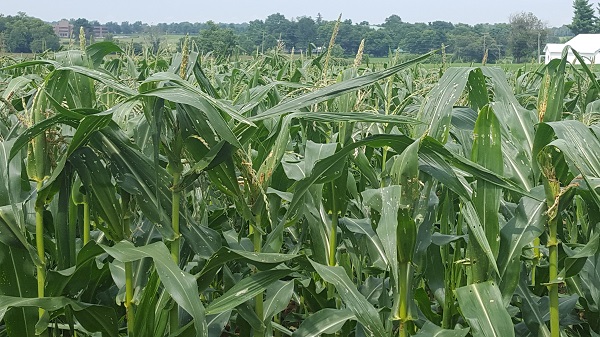Fall Armyworm in Corn
ENTFACT-110: Fall Armyworm in Corn | Download PDF
by Ric Bessin, Extension Entomologist
University of Kentucky College of Agriculture
Fall armyworm can be one of the more difficult insect pests to control in field corn. Late planted fields and later maturing hybrids are more likely to become infested. Fall armyworm causes serious leaf feeding damage as well as direct injury to the ear. While fall armyworms can damage corn plants in nearly all stages of development, it will concentrate on later plantings that have not yet silked. Like European corn borer, fall armyworm can only be effectively controlled while the larvae are small. Early detection and proper timing of an insecticide application are critical.
Each summer, adult moths move northward in progressive stages from overwinter sites along the gulf coast region and begin to appear in Kentucky in late June or early July. The spherical gray eggs are laid in clusters 50 to 150, usually on the leaves. Egg masses are covered with a coating of moth scales or fine bristles. Larvae hatch in 3 to 5 days and move to the whorl.
Figure 1. Fall armyworm has a dark head capsule with a light inverted "Y" marking.
Fall armyworm larva vary from light tan to black with three light yellow stripes down the back. There is a wider dark stripe and a wavy yellow-red blotched stripe on each side. Larvae have four pairs of fleshy abdominal prolegs in addition to the pair at the end of the body. Fall armyworm resembles both armyworm and corn earworm, but fall armyworm has a white inverted "Y" mark on the front of the dark head.
The corn earworm has an orange-brown head, while the armyworm has a brown head with dark honeycombed markings. Fall armyworm has four dark spots arranged in a square on top of the eighth abdominal segment.
Figure 2. Fall armyworm moths can be very numerous in late summer.
Very early symptoms of fall armyworm resemble European corn borer infestation. Small holes and "window pane" feeding in the leaves emerging from the whorl are common. Although initial symptoms of damage are similar, thresholds and control measures differ. Therefore it is important to find the live larvae and determine which insect is causing the damage. Unlike armyworm, fall armyworm feeds during the day and night, but are usually most active in the morning or late afternoon.
The most common damage is to late pretassel corn. Larger fall armyworm larvae consume large amounts of leaf tissue resulting in a ragged appearance to the leaves similar to grasshopper damage. Larger larvae are usually found deep in the whorl often below a "plug" of yellowish brown frass. Beneath this plug, larvae are protected somewhat from insecticide applications. Plants often recover from whorl damage without any reduction in yield.
Figure 3. Initial fall armyworm damage appears as ragged holes in the leaves.
Larvae will also move to the ear as plants begin to tassel and young ears become available. The ear may be partly or totally destroyed. Damage to the ear may be much more important than leaf damage.
Monitoring
Corn growers should pay close attention to late planted fields or fields with a history of these problems. Problems are usually associated fields planted after June 1. Early detection of infestations will allow for more effective control of this pest. If present in damaging numbers in the field, it must be controlled while the larvae are still small. Finding an infestation after it is too late to obtain good control is a serious and common problem. Because fall armyworm prefers whorl stage corn, late-planted fields should be given a high priority when scouting.
Begin checking corn in mid-June for fall armyworm activity. Survey 20 consecutive plants (selecting the first randomly) from at least 5 locations in the field. Small larvae cause "window pane" damage to leaves similar to European corn borer. A few days before tasseling, look for large larvae in the whorls which will be pushed out when the tassels emerge. These larvae may attack young ears. Continue to check for this insect until silks begin to dry. Pheromone traps are also used to monitor this insect in sweet corn.
Management
Control needs to be considered when egg masses are present on 5% of the plants or when 25% of the plants show damage symptoms and live larvae are still present. Controlling larger larvae, typically after they are hidden under the frass plug, will be much more difficult.
Treatments must be applied before larvae burrow deep into the whorl or enter ears of more mature plants. Insecticide applications by ground rig using at least 30 gallons per acre and high pressure will give the best results. In pretassel corn, direct spray directly over the whorl.
Bt corn with above ground stacked traits can provide control or high levels of suppression of fall armyworm. However, with later planting dates (after June 1) and high fall armyworm levels, all Bt corn hybrids will need to be monitored for fall armyworm activity and treated with an insecticide according to the above economic threshold.
Revised: 11/19
CAUTION! Pesticide recommendations in this publication are registered for use in Kentucky, USA ONLY! The use of some products may not be legal in your state or country. Please check with your local county agent or regulatory official before using any pesticide mentioned in this publication. Of course, ALWAYS READ AND FOLLOW LABEL DIRECTIONS FOR SAFE USE OF ANY PESTICIDE!
Photos courtesy Ric Bessin, University of Kentucky Entomology



